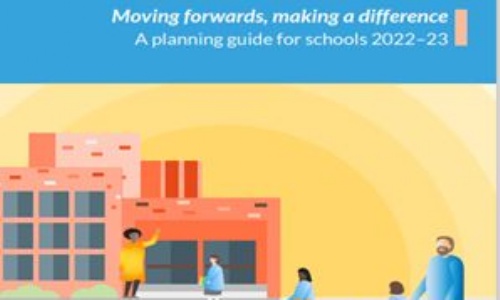Moving forwards, making a difference

"For two years, schools have been grappling with real uncertainty. Questions from whether they would be open one day to the next, to how best to support learning, both remotely and in-class, have loomed large over daily life in schools. Amidst these challenges, teachers and school leaders have worked tirelessly to mitigate the negative impacts of the pandemic on the children and young people in their care. Initially, they did so whilst working without a map, lacking evidence of how their pupils’ learning had been affected. However, over time, studies have been conducted and research evidence published. This has enabled us to begin to piece together a more robust understanding of how partial school closures have affected children, and the measures that will need to be taken to facilitate their recovery and move learning forwards.”
 These were the words last week of Professor Becky Francis, CEO of the Education Endowment Foundation, in her post to launch the latest EEF Evidence review The Impact of COVID-19 on Learning: A review of the evidence.
These were the words last week of Professor Becky Francis, CEO of the Education Endowment Foundation, in her post to launch the latest EEF Evidence review The Impact of COVID-19 on Learning: A review of the evidence.
The key findings are sobering, but perhaps not surprising to those of us who work in schools.
Key findings:
- COVID-19-related disruption has negatively impacted the attainment of all pupils, particularly those from disadvantaged backgrounds.
- There is evidence that the attainment gap between disadvantaged students and their classmates has grown.
- There is some evidence that in primary schools, younger year groups (Key Stage 1 pupils) have been the most significantly affected, with lower attainment than previous cohorts across all subjects. Other recent research shows particularly negative impacts for pupils in KS3 (DfE, 2021, 2022).
- Most evidence shows that despite some recovery by summer 2021, on average pupils were not performing as well in both maths and reading as pre-pandemic cohorts.
- Aside from the impact on attainment, which this report focuses on, teachers have frequently reported concerns around the effect on pupil wellbeing. There is also emerging evidence that suggests the pandemic has negatively impacted children’s mental health.
The report goes on to explore these findings in more detail, and the text is interspersed with vignettes from schools, outlining the issues they have identified, and the curriculum adaptations they are making to address these.
|
“The impact on Covid presented itself in a variety of ways in our classrooms, from challenges around resolving conflict between peers, to lack of fluency in reading and number work. This is particularly apparent for our lower Key Stage 2 children, whose entire experience of Key Stage 1 was disrupted. One of the most significant challenges we have identified has been with children’s writing, in particular, their handwriting. In pre-pandemic times, our children would enter lower Key Stage 2 having received regular explicit teaching with careful feedback throughout Reception and Key Stage 1, ensuring their readiness to build and grow a focus on composition. However, this current cohort of children has developed a range of handwriting styles in lockdown, due to long periods away from the careful monitoring and guidance of teachers. To remedy this, we have focused on letter formation across the school, with teachers monitoring and providing feedback on children’s handwriting process, rather than the product.” Cragside C of E Primary School, Cramlington |
|
Towards the end of the report is a summary of guidance and resources that are available from The EEF to support ‘education recovery’ planning.
These include Moving Forwards, Making a Difference: A Planning Guide for Schools, 2022–23.
 This new guide is designed to support teachers and school leaders in identifying and addressing the key areas for development in their setting for the coming academic year. It offers practical advice and signposts evidence-informed resources on a variety of areas of teaching practice, from ensuring high quality teaching to removing non-academic barriers to attainment.
This new guide is designed to support teachers and school leaders in identifying and addressing the key areas for development in their setting for the coming academic year. It offers practical advice and signposts evidence-informed resources on a variety of areas of teaching practice, from ensuring high quality teaching to removing non-academic barriers to attainment.
You may find these particularly useful, among others:
Page 7 of the document - High quality daily teaching: the 'five-a-day' approach:

Page 11 of the document - Using diagnostic assessment to identify learning gaps

Page 18 of the document - Successful academic intervention: the TARGET model

The report also points us back towards the updated Teaching and Learning Toolkit, which may lead us to reflect on when we last revisited the Toolkit and really explored it in depth. After all, now more than ever we really need to focus on the evidence of what works in closing gaps in pupils' learning and accelerating their progress.
The Toolkit will therefore be the focus of our next Spotlight article. In the meantime, you may want to revisit it yourself here.
To read our other Spotlight on Evidence posts, click here.
To sign up to receive new Spotlight on Evidence posts directly to your inbox, click here.
You can download this article below.
